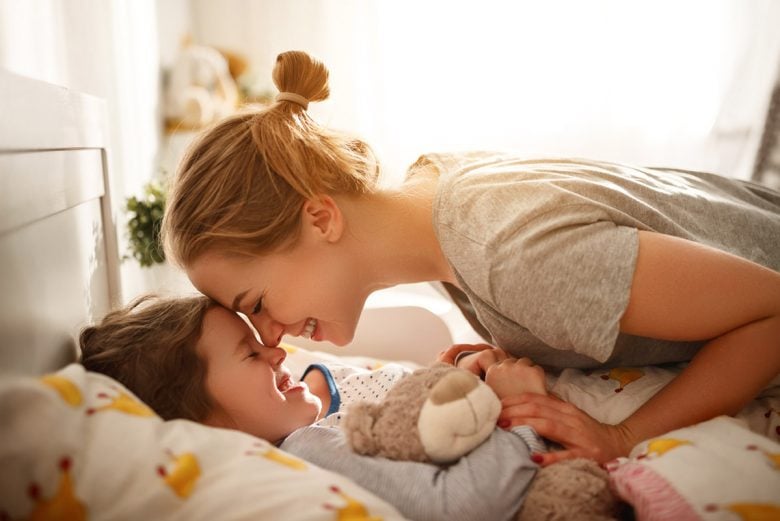
Getting your child to sleep can be easier.
Sleep. Even though your children do it every single day, they can fight it hard. If sleep becomes a battle, it’s exhausting for both of you. So what can you do to help your child go to sleep and have healthy sleep habits?
In this episode, Carol and Anne share tips to support all 4 Types of children in going to bed more easily.
This episode’s Parenting Practice
Focus this week on helping your child look forward to sleep, rather than allowing it to turn into an experience of resistance or punishment. This episode includes sleep ideas for all 4 Types. From the tips shared, what’s one correction or improvement you could make?
Transcript of podcast episode
Anne: Oh. Yeah. I mean, I’ve definitely, when my child is woken up early from their nap. I’m like, “No. I don’t hear you. I still have things to do.”
Carol: Welcome to “The Child Whisperer” podcast. I’m your host Carol Tuttle, author of the best selling parenting book, “The Child Whisperer.” I’m with my co-host, Anne Tuttle Brown.
Anne: I’m a Type-1 mom of a 21-month old Type-1 girl. She has always been a good sleeper, but the last five months something has changed. Getting her to sleep is hard. It’s, like, all of a sudden, she has this burst of energy and starts bouncing off the walls. She’s not being disobedient. She’s just not sleepy. I know I hate being forced to sleep, and so I try to treat her how I would want to be treated. But this is just a mystery I can’t figure out. Is this normal for Type One children, and do you have any suggestions?
Carol: I would say based on the time period she’s talking about, at about 16 to 18 months old, children typically drop a nap. It’s an awkward phase for the fact, that by about 5:00, let’s say they go from two naps a day, and if they get two naps a day, suddenly they’re up till 9:00 or 10:00. So you drop the nap, and you have either a morning or afternoon nap, and all of a sudden, they’re really in an angst around 5:00. It’s just a funky space that you’ve gotta move through, where they can solidly go with one nap a day to suddenly, there’s no naps. When did Katie? You have a Type Three child, a high… Type One and Type Three children are higher movement. When did she quit napping during the day?
Anne: It was, I think around, two and a half. She dropped, [makes sound]
Carol: Were you like… Yeah. Were you like, “Oh?”
Anne: No.
Carol: Like, “No. You’re awake all day.”
Anne: Yeah. Definitely. “When is bedtime?”
Carol: Because you… You needed her to nap.
Anne: For sure.
Carol: Right.
Anne: Yeah. I’ll admit it.
Carol: So there’s some of that going on in here, I think, too, the Type One mom’s not getting her out, and the nap becomes the break, and so you notice when children don’t sleep as much as they used to, because you relied on that for your own, sort of, sanity to get things done, take care of yourself, get a break from your children. And so make sure you’re getting breaks through child care, or play dates, and babysitter swapping, things like that. And so you’re saying that there’s not an issue with her behavior. Maybe you need it more than the child needs it. Because we do, parents do depend on their children sleeping to get breaks from them.
Anne: Oh. Yeah. I mean, I’ve definitely, when my child has woken up early from their nap, I’m like, “No. I don’t hear you. I still have things to do. You’re throwing off my schedule.”
Carol: Yeah. Great. “No. Sorry. You’re not supposed to be waking up for 30 minutes.”
Anne: I know.
Carol: “What do you think you’re doing here?” Well, let’s give some tips, though, for each of the four types that will support them in good sleep habits. There’s been a lot of research on sleep in the last 5 to 10 years. And it’s just become more mainstream to understand, we don’t give ourselves, as a culture, in a high tech, very digital world, the right sleep support. And there’s big consequences for it. And so I’ve read books on this. The, just understanding your own nature, I think, is a big piece of it as well, which the four types that you lead with, and how to teach your children how to have healthy sleep patterns. So it’s a sort of a behavioral training opportunity so that they’re noticing their own cues because you are, and rest becomes something they look forward to and sleep, versus something they’re fighting. And I think the parent’s attitude is a big beginning on that, because if you need your child to go to sleep for your own emotional well being, a child is gonna feel on some level, you don’t want me around, and they will push back. They will…
Anne: Bedtime is punishment.
Carol: Yeah. There is frustration then, that the child will reflect back to you and there’ll be resistance. And so is there a invitation, supportive energy around going to sleep, versus, “It’s bedtime,” and it’s always a hassle, and it’s fights and resistance. So what’s the pattern you’ve created around that? But let’s talk about each of the four types of children. We’ve got our Type One child, who is a higher movement, more upward-like, random, inconsistent to consistency. So it would seem reasonable that this little, this child, this little girl is switching up her sleep patterns, because she has a more random nature.
Anne: There’s also a tendency with Type Ones of the fear of missing out. And so if it’s a nap and there’s lots of people in the house…
Carol: Yes.
Anne: And my brother-in-law and his wife recently visited us, and they have a Type One two-year old. And she had a hard time going to nap, because she was napping in, like, the family space, and she could hear the other children playing. And so her mom had to go, like, lay with her, or at home, she would have been, like, in a darker space, where the noise wouldn’t have had, you know.
Carol: Yeah. There’s nothing going on at home. So, yeah. What’s distracting them, that’s getting their attention? Your sister, our oldest daughter, is a Type One, and I didn’t have this information in her early years. And I look back, and I can see, that if we had certain activities or the TV on, things happening, she didn’t wanna miss out. She was this bright-eyed, sort of, “What’s going on. I want to be out there with you.” So you do have to…
Anne: That social connection to the world.
Carol: Yeah. And if there is an obvious distraction that’s getting their attention, they’ll have a difficult time disconnecting from that.
Anne: And I think with bedtimes, they can be fast, playful. I don’t think it has to be this long, “Okay. Let’s get you sleepy now.” I think that maybe this little girl has a burst of energy, because that’s what she needs right before she goes to bed is, some, you know, just really play time, stories, fun, and then, “Okay. Like, that bottle has been filled now. I’m gonna go to bed.”
Carol: And if this is, she’s not sleeping as many naps, she just may not need them, because of an age factor.
Anne: Yeah. I think what you shared in the beginning is…
Carol: Now, Type Two child has more ability due to their detailed, planned out approach to life, to submit to a more expected routine. Our twin granddaughters are a Type Two and a Type Four. And I was babysitting them the other night, and I said to them, “You could put grandma to bed. You know all the steps,” because it’s very regimented and it has to be a certain order. And they respond very favorably to that due to the fact, your Type Two is, “Here’s the bedtime plan,” and the Type Four is, “There’s an infrastructure to going to bed, and we just repeat it every night.” And that works very well for them, because they like that kind of order and predictability. So is your Type Two comfortable in bed as well?
Anne: So that’s what works for us.
Carol: What’s inviting to them?
Anne: We don’t have a very consistent routine that we do every night. We don’t do baths every night, we don’t do story every single night, and so it looks a little bit different. But he can always expect, “Cozy the jammies,” this is my Type Two, two-year old.
Carol: Your Type Two son.
Anne: He gets a bottle, he gets his, he has, like, three blankets and a bunch of stuffies. He loves those, that connection.
Carol: He, so the comfort level you’ve created, he relates to, “I have an extra comfortable, soothing experience when I go to bed.”
Anne: And I know he looks forward to that. And then that connection.
Carol: Yes.
Anne: I give him the big hug. I hold him for a minute, we turn on his noise maker. He knows, like, what happens in the bedroom space, he knows what to expect, and so that makes it very comfortable and familiar.
Carol: And those are features of comfort he doesn’t experience during the daytime. I notice that with Ruby and Addie, they only get their binkies, when they’re in their comfort zone, in the bed, sleeping space. So they’ve saved certain things to relate to, comfort equals going to sleep. That works really well for a Type Two. For a Type Three child, they’re the sort of push, push, push, crash.
Anne: Play hard, work hard, sleep hard.
Carol: Yes. So in helping them to develop healthy sleep habits, not a good idea to have them in front of TVs, and electronics, and stimulating… That’s, I think we need to avoid that for all children. They found that if we stimulate through blue light, through the technology we’re engaged in with tablets, and phones, and television within an hour of when we go to sleep, we’ve turned on certain parts of our brain now that aren’t going to allow the REM state to kick in. So for everybody, let’s avoid that. For Type Three children especially, they need that, have they expired or they’re just, like, kind of done. They’re ready to crash.
Anne:Yeah. I’ll find that my daughter after a big day of playing outside, being with lots of people, she’s ready for sleep. And she just, what works well for her is that physical connection with her. Like, she’s six years old, but it’s still very hands-on bedtime, moving her through the process. And I’ll lay down with her, tell her a story. But we can move quickly through that whole process.
Carol: Yeah. And when she hits the pillow, she goes, they go out pretty fast, because they just… That’s true for our grandson, Joseph. And it’s just, you wouldn’t think he’s tired, till he hits the pillow, and then bam, he’s out.
Now your Type Four child has a lot of ability to put themselves to bed. Of all of our kids, Mark was the one that had the most sense of reason when it came to bedtime, because he would just consider it’s reasonable to go to bed when you’re tired. So he’d put himself to bed. He’d say, “Well, I’m going to bed because I’m tired.” So having a child learn, I think all types could learn this, reading their own tired cues. “I’m tired. That means I need to go to bed.” Type Four children relate, they’re at a high level to that, for self-care and being their own authority, so that you can then support that process for them. In fact, I would make sure I’d go in and say good night to him, because I could’ve skip that step and not had that opportunity to connect with him, because he was so, he so easily put himself to bed. Even at a young age, he’d started doing this around five or six. And I would make sure I’d go to his room and do a little bit of a ritual with him, and just say good night to him, so that I wasn’t just letting him be so responsible, that he didn’t get that parent connection.
Understanding your child’s energy type is the first step. So this week’s practice is, from the tips that we’ve shared, what’s the one correction, improvement could you make to support your child in creating healthy sleep habits? And honoring the experience of sleep and looking forward to it, rather than having it an experience of resistance and punishment.
Thanks for listening. For more support, go to thechildwhisperer.com, where you can purchase the book, subscribe to our weekly parenting practice email, and find a transcription and audio of the Child Whisperer broadcast.
Anne: If you’re listening on iTunes, thank you for leaving a review. If you have a parenting question, please send it to [email protected].



